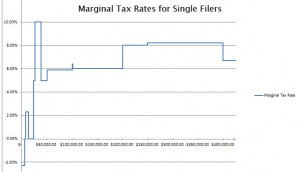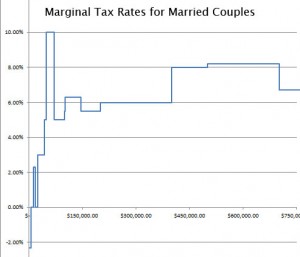When average Connecticut taxpayers completed their returns for the deadline earlier this week they may have paid marginal rates higher than the state’s top tax bracket because of the way the state phases out certain deductions.
Marginal taxes determine how much of the next dollar a person earns he or she will get to keep.
For example, residents in the highest tax bracket have a marginal rate of 6.7 percent. For every dollar they earn after federal taxes, they get to keep 93.3 cents.
Connecticut single filers pay no taxes on the first $13,000 of their income, but the state undoes that exemption once the person starts earning $26,000 a year. Between $26,000 and $38,000 an individual pays the state’s highest marginal tax rate, 10 percent.
 About 125,000 individual filers earn between $25,000 and $40,000, the closest approximation available in the Department of Revenue Services 2010 Income Tax Reports.
About 125,000 individual filers earn between $25,000 and $40,000, the closest approximation available in the Department of Revenue Services 2010 Income Tax Reports.
For married couples, the highest marginal tax rate occurs when they earn $48,000 to $71,000.
Just over 100,000 married couples earn between $48,000 and $74,000, according to DRS.
Based on these estimates it is possible that as many as 300,000 people are paying the state’s highest marginal tax rate.
The 10 percent marginal tax rate is made up of two components: the 5 percent tax bracket and the phase-out of the personal exemption, which amounts to a second 5 percent tax.
 In other words, these taxpayers only get to keep 90 cents of every extra dollar they earn until their income rises above the phase-out period.
In other words, these taxpayers only get to keep 90 cents of every extra dollar they earn until their income rises above the phase-out period.
These high marginal tax rates are not new. They predate Gov. Dannel Malloy’s record 2011 tax increases.
According to the Tax Foundation, Connecticut residents work until May 5 to pay off the taxes they owe federal, state and local governments, longer than in any other state.
Economists give marginal tax rates – the tax rate on the next dollar earned –more importance than average tax rates because marginal tax rates affect behavior.
People make the decision whether to work more or to enjoy more leisure at the margin. As marginal tax rates rise, people trade work – which has less value to them because of the tax – for more leisure time.
“If incentives matter, we must expect that higher marginal tax rates may actually reduce the incentive to earn or seek out additional income,” Trinity College economics Prof. William Butos said in an interview last summer.
For a summary of the effect of marginal tax rates at the federal level, see the complete interview with Butos.
An individual earning $250,000 to $400,000 pays the second-highest marginal tax rate, 8.2 percent, as a result of last year’s tax increases. After $400,000, the marginal tax rate falls to 6.7 percent.
The 8.2 marginal rate for married couples occurs between $500,000 and $700,000. This rate is the result of the 6.7 percent bracket plus “benefit recapture” provisions that go back and tax dollars earned in lower brackets at higher rates.
The state also phases out the 3 percent bracket and the property tax credit causing similar bumps in marginal rates.
Malloy’s budget last year also included a negative income tax, known as an Earned Income Tax Credit. At the margin, recipients of the EITC get 1.023 dollars for every dollar earned.
Once residents reach a certain income threshold, their marginal tax rate rises to zero and then it rises again to 2.3 percent to take away the EITC benefits.
Note: The charts showing marginal tax rates are based on an interpretation of several tax provisions, but not all of them.

King Dannel is looting the working class and still the state is in deficit. Money that was supposed to be for roads and bridges gets diverted to the general fund…. and now this cash strapped state doesn’t have the money to repair the existing infrastructure but is giving a half a billion sweetheart project undoubtedly to union contractors to build a bus way between Hartford and New Britain that will serve no economic purpose…. but brace yourselves for increased fees and taxes, including the gas tax justified by the “crisis” of crumbling bridges and roads that we had already collected enough money to repair had legislative thieves kept their greasy meat hooks out of the proverbial cookie jar.
Why we are moving north to New Hampshire. Had enough.